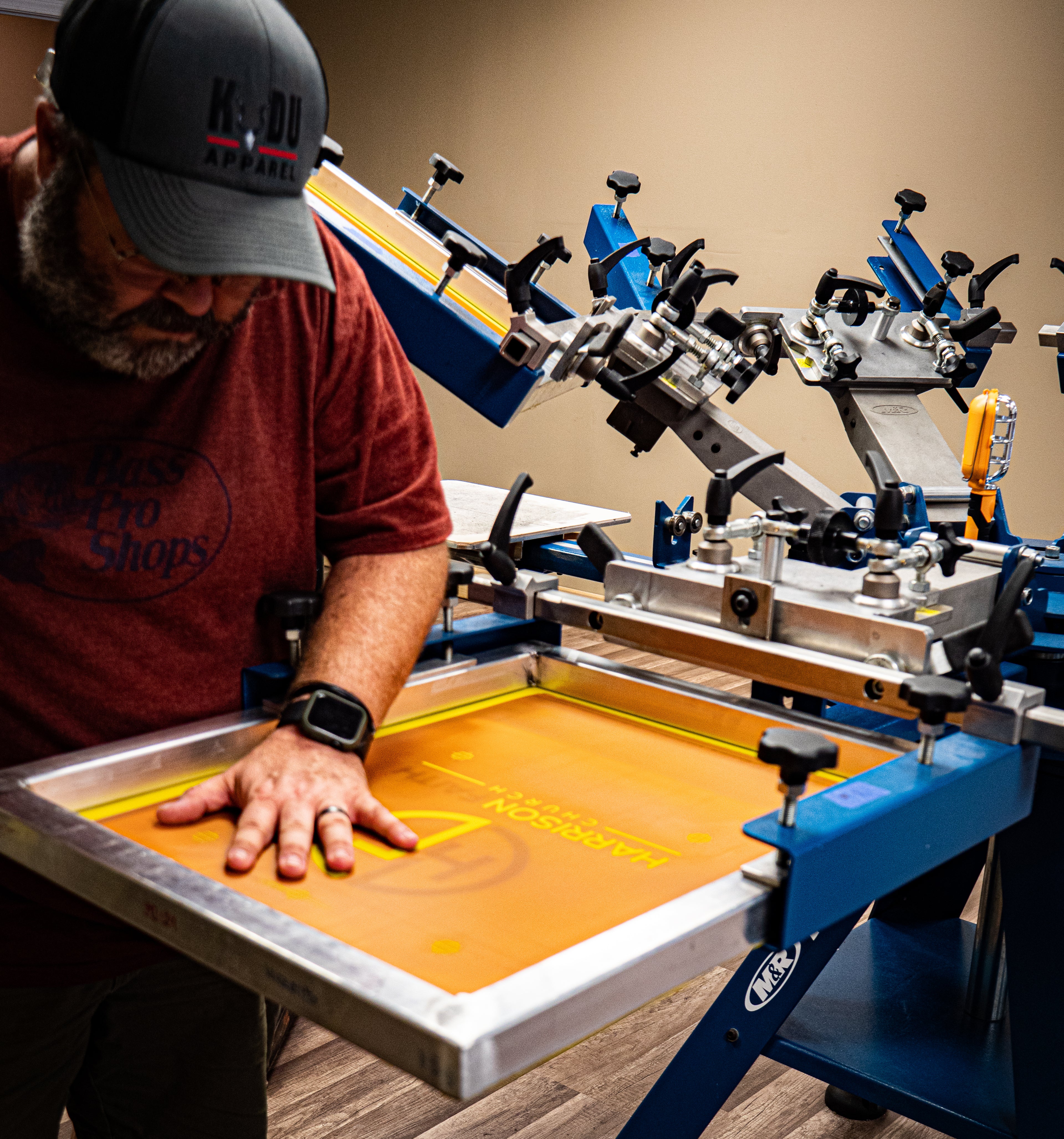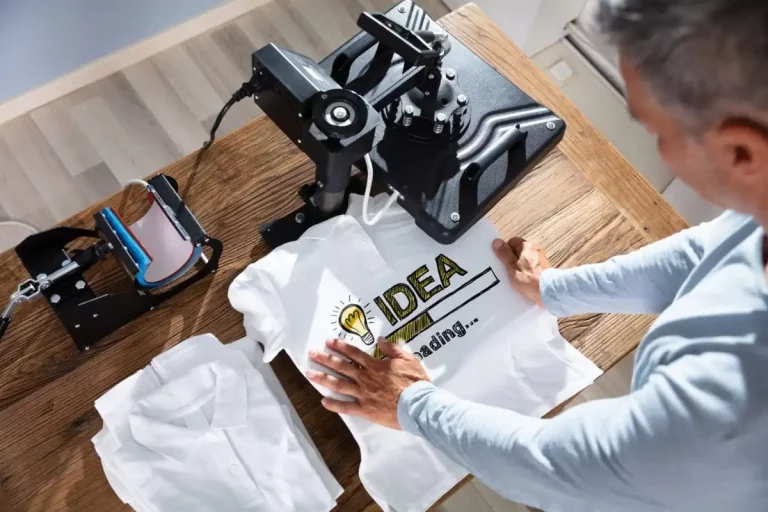Budget-Friendly T-Shirt Printing for Startups
Budget-Friendly T-Shirt Printing for Startups
Blog Article
Display Printing Uncovered: Whatever You Need to Understand About T-Shirt and Garment Printing Techniques
If you've ever wondered just how those dynamic styles end up on your preferred tees, you remain in the appropriate location. Screen printing is a fascinating approach that integrates art with strategy, offering countless possibilities for creative thinking. Recognizing the fundamentals, from tools to ink choices, can considerably influence your outcomes. Ready to check out the vital elements that make display printing an art type? Allow's uncover the details that can elevate your tasks.
The Essentials of Screen Printing: Just How It Works
When you plunge right into screen printing, you'll find it's both an art and a science. At its core, display printing involves producing a stencil, or screen, that permits ink to travel through only in certain locations (screen printing kit). You begin by selecting your style and preparing your display with a light-sensitive solution. When you subject this solution to light, it solidifies, leaving your design as an adverse room.
Following, you'll blend your inks and prepare your printing surface. Placement the display over the material, then utilize a squeegee to push ink via the display onto the garment. This process calls for accuracy, as you want clear, lively prints. After printing, you'll treat the ink with warm, ensuring it adheres to the fabric and lasts with laundries. Each step is important, and understanding them will raise your screen printing skills, changing basic garments right into special, meaningful pieces.
Types of Screen Printing Methods
As soon as you understand the fundamentals of display printing, it's time to discover the numerous methods that can raise your layouts. One preferred technique is traditional screen printing, where ink is pressed with a stenciled screen. This strategy is wonderful for bold, dynamic colors. Then there's water-based ink printing, which provides a softer feel and is environmentally friendly, but it requires a different method to treating.
If you're aiming for great information, consider discharge printing. This technique removes color from the textile, leaving a soft, classic appearance. An additional choice is plastisol printing, known for its toughness and vivid shades, making it a preferred for lots of brands. Lastly, try out halftone printing to produce gradient effects and intricate designs. Each strategy has its unique appeal, so don't hesitate to attempt them out to discover what suits your design best!
Essential Tools for Screen Printing
To achieve spectacular outcomes in display printing, having the ideal tools is essential. You'll require a durable display printing frame, which holds the mesh that moves your style onto the garment. Next off, invest in high-quality mops; these are crucial for applying ink uniformly throughout the screen. You'll also call for a good exposure system to create your displays, along with a washout booth for cleansing them after use. A trustworthy heat resource, like a conveyor clothes dryer or warm press, is critical for treating your prints to ensure long life. Do not forget an appropriate work space, geared up with tables and storage for your products. Finally, protective gear, such as masks and gloves, will certainly maintain you secure from chemicals and inks. With the right devices, you'll be well on your means to producing professional-quality prints.
Selecting the Right Inks and Products
When selecting inks and materials for screen printing, you require to consider the sort of ink that functions ideal for your job. Believe regarding material compatibility to ensure your designs look last and fantastic long. Discover green ink choices to make your printing process much more sustainable.
Sorts Of Display Inks
Choosing the appropriate display ink is essential for attaining lively, durable prints that meet your task's requirements. There are several sorts of display inks to check out. Plastisol ink is preferred for its adaptability and ease of usage, giving superb color opacity on dark textiles. Water-based ink, on the various other hand, supplies a softer feel and is environmentally friendly, making it suitable for those seeking to lessen their environmental effect. Discharge inks eliminate color from the material, resulting in a soft, classic appearance but require details handling. Specialized inks, such as glow-in-the-dark or metal, can add one-of-a-kind effects to your designs. Examine your project demands and pick the ink that lines up best with your wanted outcome.

Material Compatibility Considerations
Recognizing fabric compatibility is vital for accomplishing premium screen prints, specifically considering that different products respond distinctively to numerous inks. Constantly test your inks on example textile to ensure they adhere correctly and keep color honesty. In addition, maintain in mind that fabric weight and structure can influence the final result, so choosing the best ink and product combo is essential for your project's success.
Eco-Friendly Ink Options
Eco-friendly inks are coming to be a preferred option for display printers who wish to decrease their ecological effect while keeping quality. When selecting inks, take into consideration water-based inks, which are much less dangerous and much easier to cleanse up compared to typical solvents. These inks bond well with materials, supplying vivid results without toxic chemicals. You might likewise discover eco-solvent inks that use fewer unstable natural substances (VOCs), making them a safer choice for both your health and wellness and the earth.
Furthermore, try to find inks made from renewable energies, such as soy or vegetable-based options. By picking the appropriate inks and products, you'll not only produce magnificent designs yet additionally add to a much more sustainable printing procedure. Make the switch, and your prints will show your dedication to the atmosphere!
Preparing Your Style for Display Printing

File Format Demands
To ensure your layout looks sharp and dynamic on textile, you'll require to pay close interest to file style needs for display printing. Make sure your design has a transparent background to avoid unwanted white sides on your prints. Keep shade settings in mind; CMYK is standard for screen printing, so convert your RGB designs as necessary.
Color Separation Techniques
Color separation is a necessary action in preparing your design for screen printing, and mastering it can substantially enhance your print top quality. You'll need to break your style into specific colors, as each shade requires a separate display throughout printing. Begin by identifying all the colors in your style and produce layers for each one. You can make use of software like Adobe Photoshop or Illustrator to isolate and separate colors successfully. Be certain to save each layer as a different documents, commonly in a style like TIFF or PSD. This accuracy not just assures precise shade depiction but likewise enhances the printing process. By taking notice of color splitting up, you'll attain vivid and professional lead to your screen-printed garments.
Resolution and Dimension
Accomplishing the very best lead to display printing starts with guaranteeing your design has the right resolution and size. Ideally, your artwork needs to go to least 300 DPI (dots per inch) for sharp, clear prints. Your last item might look pixelated and less than professional. if you use reduced resolution.
When it pertains to dimension, take into consideration the dimensions of your print location. Style your artwork to match the final print size, ideally creating it in the actual measurements you'll be printing. In this manner, you'll avoid any type of unforeseen scaling problems.
Constantly examine your layout in both vector and raster layouts. Vector graphics can be scaled without shedding top quality, making them suitable for screen printing. Preparing correctly will guarantee your layout looks amazing on every garment!
Step-by-Step Screen Printing Refine
Display printing is a vibrant procedure that enables you to develop vibrant styles on various surface areas. To obtain started, you'll need a display, emulsion, and your selected ink.
After cleaning out the unexposed emulsion, your display is prepared. Set it up on your printing surface area and straighten your garment underneath it. Pour ink onto the screen and use a squeegee to push the ink with the stencil onto the fabric. Lift the screen carefully and allow the print dry. Cure the ink making use of warm to ensure longevity. That's it! You've efficiently screen printed your layout.
Tips for Successful Display Printing Projects
While you're diving into your display printing projects, keep in mind that preparation is vital to success. Begin by collecting all your materials-- inks, garments, mops, and screens. A tidy office helps protect against unwanted errors, so clean up prior to you begin.
Next, validate your art work is high-resolution and effectively sized for your garment. Check your display for appropriate exposure and clean it thoroughly to prevent spots. When mixing your inks, comply with the producer's standards to attain the best consistency.
During printing, apply even pressure with your squeegee for constant outcomes. Don't rush; take your time to confirm each print fulfills your standards. After printing, allow your garments completely dry completely before handling or packaging them.
Last but not least, always keep a sample of your help future recommendation. By doing this, you can evaluate your progression and improve your methods over time. Delighted printing!

Regularly Asked Concerns
How much time Does It Take to Set up a Screen Printing Job?
Establishing a screen printing job normally takes about 30 mins to an hour. You'll prepare the screens, you could try these out mix inks, and change the press. The moment differs based upon complexity and experience, so stay organized!
Can I Print on Various Textile Keys In Making Use Of the Very Same Method?
Yes, you can publish on different fabric kinds making use of the exact same method, but you'll need to adjust your inks and settings. Some materials soak up ink in a different way, so experimenting guarantees the ideal outcomes for every material.
What Prevail Blunders to Prevent in Screen Printing?
When display printing, avoid typical mistakes like making use of the incorrect ink, overlooking proper exposure times, or missing pre-press checks. Constantly check your configuration and preserve clean displays to guarantee top top article quality results each time.
Exactly How Can I Correctly Tidy and Preserve My Display Printing Equipment?
To effectively tidy and preserve your display printing devices, you need to routinely clean screens with appropriate solvents, inspect mops for wear, and ensure all devices are kept completely dry and dust-free. Uniformity boosts and avoids expensive repairs performance.
Is Display Printing Eco Pleasant Compared to Various Other Approaches?
Display printing can be much more eco-friendly than other approaches, specifically if you utilize eco-conscious materials and water-based inks. By picking sustainable products and practices, you decrease waste and decrease your influence on the planet.
Display Printing Uncovered: Every Little Thing You Need to Know Regarding Tee and Garment Printing Strategies
At its core, display printing involves producing a pattern, or display, that permits ink to pass with only in particular locations. Placement the display over the textile, then use a squeegee to press ink with the screen onto the garment. One prominent approach is conventional display printing, where ink is pressed with a stenciled display.When choosing inks and products for screen printing, you need to take into account the type of ink that works best for your task.
Report this page